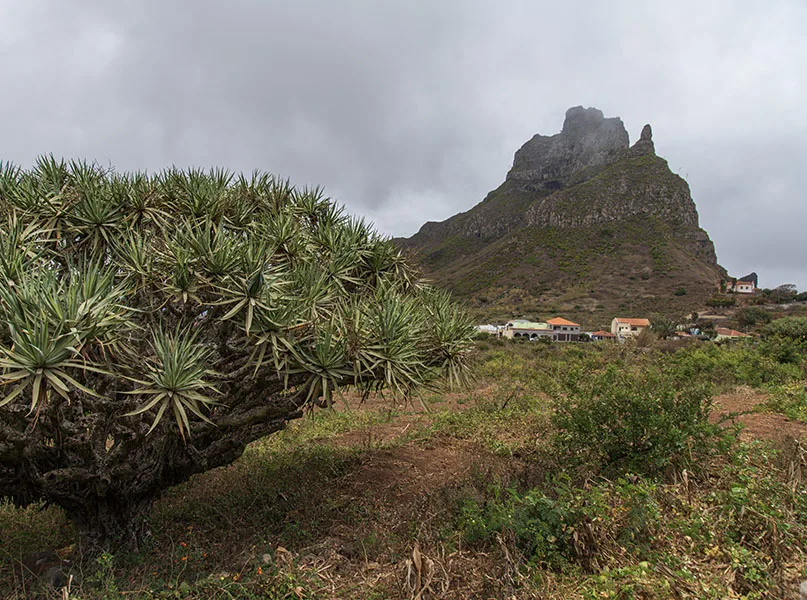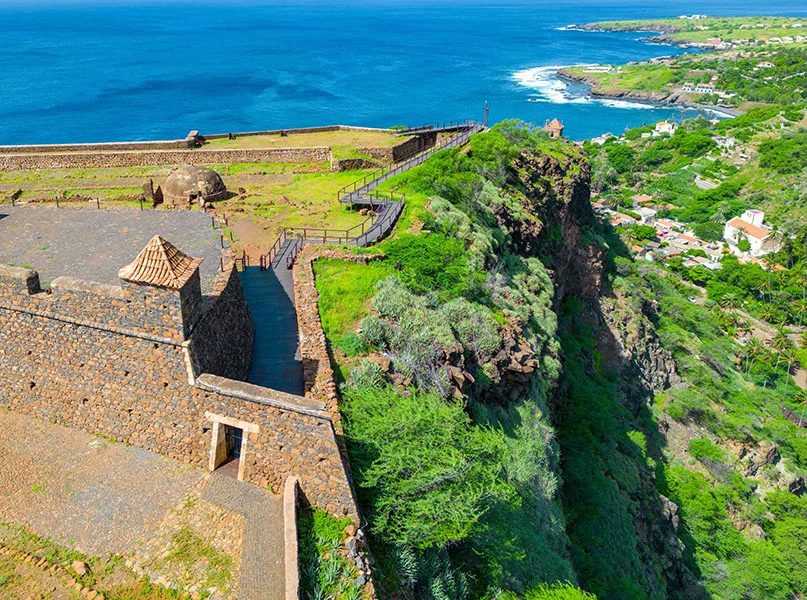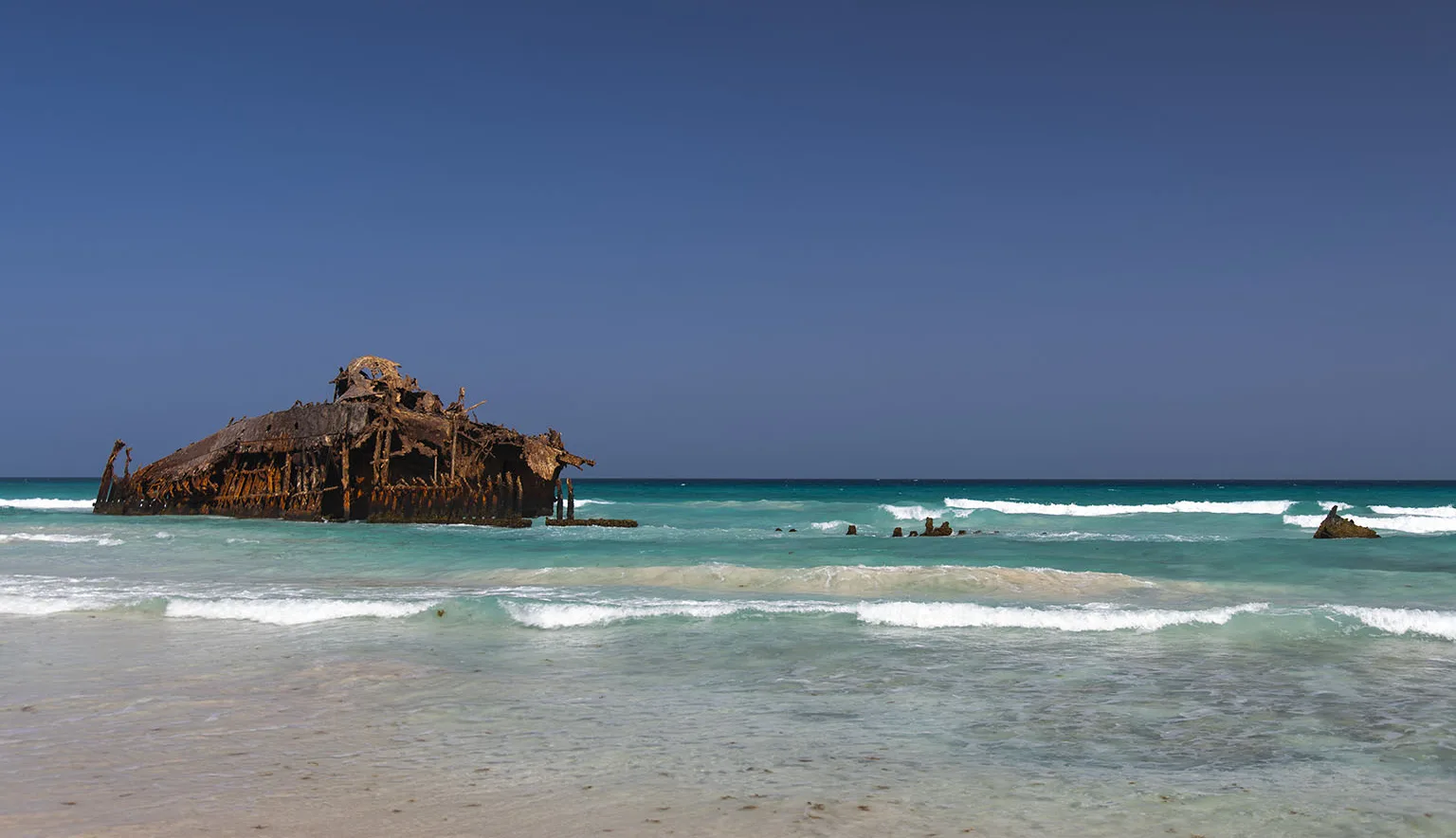Comprising soaring mountain rises, emerald pastures, and a highly unique and authentic musical heritage still enjoyed by many today, Cabo Verde delights with its infectiously joyous atmosphere.
CABO VERDE
As the jagged and spirited neighbour of West Africa, Cabo Verde offers a mountains cape that disrupts the soaring skies of the North Atlantic Ocean.
Comprising 10 volcanic islands, the archipelago was formed from powerful magma erupting from the depths of the sea. Today, travellers and residents alike are humbled by its verdant brilliance and rugged dominance, offering a multitude of unique and spectacular sights including Pico do Fogo, the largest peak in Cabo Verde’s lofty collective.
From the skies to the sand, the country’s beaches have a reputation for being some of the best in the world, as travellers are blessed with sunshine all year round.
Gently floating through the vast skies above the ocean, beachgoers may notice iridescent colours cast by the abundance of kitesurfing, which has become a keen pastime in recent years. To fully experience the delights of this emerging sport, travellers are best advised to visit Cabo Verde in kitesurfing season between October and May.
Hotspots for the activity include Cabo San Lucas, with vast stretches of uninterrupted sand offering powerful winds. Additionally, the island of Sal is home to the aptly named Kite Beach, one of the nation’s most beloved kitesurfing spots for both professionals and those just starting out.
Taking a gentle stroll, travellers will migrate from the tranquil atmosphere of the beach to the thrilling chaos and vibrancy of Cabo Verde’s colourful towns and welcoming communities. The kindness of the locals is perfectly characterised by ‘MORABEZA’, exuding the instinctive warmth and hospitality of Cabo Verdean people that extends to every traveller.
At the heart of the nation’s culture are the rich, erratic, and fun sounds of the islands’ music scene. One genre, the funaná, is most distinctly characterised by its joyful accordion melodies. Morna, meanwhile, is the country’s national music style and steeped in the archipelago’s heritage, sprinkled with undulating rhythms, exquisite poetry, and communal dance.
Cabo Verdean music cannot be explored without mentioning the batuque, an electric and vibrant dance genre that enraptures the ears with thundering drums and indescribable spirit.
Considered to be one of the oldest music styles, it had a revival in the 1990s, giving the genre a new style and deserved popularity. This was particularly the case when pop music icon Madonna brought a group of batuque drummers on tour, delighting millions of listeners.
The vibrancy and contagious spirit of its people, the spectacle of its magnificent mountains, and the streaming sunshine make Cabo Verde a highly diverse and colourful destination.

Q&A WITH CABO VERDE TOURISM INSTITUTE
A government subsidiary and the official travel portal for the archipelago, the Cabo Verde Tourism Institute (CTVI) promotes the magic of the country on an international scale. The institute works hard to market the warmth of the nation’s people, its adrenaline-filled sporting activities, and plethora of wonderous carnivals and festivities.
Dr Carlos Jorge Duarte Santos, Minister of Tourism and Transport, and Francisco Martins, Executive Member, tell us how the government actively supports the tourism industry and why Cabo Verde should be at the top of travellers’ bucket lists for 2025.
Firstly, can you talk us through the Cabo Verde Tourism Institute’s purpose and mission?
Francisco Martins, Executive Member (FM): The Cabo Verde Tourism Institute (CVTI) is a government body that falls under the supervision of the Ministry of Tourism and Transport, which has its statutes approved by law and responds as a National Central Entity for the execution of the government’s public policies in areas such as regulation, inspection, licensing, destination promotion, training, and other responsibilities.
How does the Ministry of Tourism and Transport support the industry in Cabo Verde?
Dr Carlos Jorge Duarte Santos, Minister of Tourism and Transport (CJDS): The Ministry of Tourism and Transport, the governmental department, defines public policies and the strategy of the tourism industry within the scope of the government programme, incorporated in the Strategic Plan for Sustainable Development (PEDS), which chose tourism as a locomotive of development and the sector that induces all economic activities.
In such a way, tourism represents 25 percent of GDP, being the sector that creates the most jobs, especially for young people, the majority of whom are women.
How do you promote Cabo Verde and everything it has to offer as a travel destination?
FM: Over the years, CVTI has actively promoted the country at international fairs to issuing merchants in conjunction with large operators and incoming agencies in Cabo Verde. Recently, the definition of a new diversification strategy for both products and the market, following the guidelines of our Strategic Marketing Plan and our social and digital networking, have been strong vectors of promotion.
Another form of promotion that has had very positive results is the organisation of and participation in major events, both in the country and abroad, as well as the sponsorship of water sports events, namely kitesurfing, windsurfing, and sport fishing.
It is also worth highlighting that Cabo Verde recently approved a new tourist brand slogan: ‘Cabo Verde, From the Heart’.

In what ways has Cabo Verde’s tourism industry evolved since you became Minister of Tourism and Transport in 2020?
CJDS: My entry into the government practically coincided with the advent of the COVID-19 pandemic. Between 2020 and 2021, we therefore focused on implementing measures to mitigate the effects. This ultimately impacted all economic activity, causing a financial contraction of around 20 percent and more than 20,000 job losses.
We responded quickly with an extended and successful vaccination campaign and promoted the tourism industry’s recovery in 2021 with an ambitious tourism renaissance plan, whose main pillars were health and safety, product diversification, sustainability, company support for employment and families, training and valuation of tourism professionals, and the introduction of the Tourism Operational Programme (POT).
It was a very challenging period, and certainly one with much unpredictability, but in light of the current reality, we can say that we managed to overcome it and get the country back on the right path safely.
In 2022, POT was approved by the government and financed by the state and World Bank. Budgeted at around €235 million and set to last until 2026, POT is structured into five sub-programmes:
- Requalification of tourist offerings that aim to qualify and diversify tourism experiences.
- Governance that aims to reinforce institutional articulation and tourism and local planning.
- Tourism promotion that primarily aims to implement the marketing plan, focusing on digital marketing and important projects to improve regional and maritime connectivity.
- Sustainability that aims to respond to the sector’s environmental, social, and economic challenges.
- HR Requalification that complements the diversification and qualification of the national tourism product through the extensive training of young people in segments already identified as priorities.
We also organize major international events in the country, such as the 64th Regional Commission for Africa (CAF), under the auspices of UN Tourism, maintaining Cabo Verde’s status as a member of the Executive Board for the second consecutive term.
In addition to cultural festivals, Cabo Verde also holds international events. In 2023, the country held the first International Conference on Nature Tourism.
In terms of transport, we moved forward with the restructuring of Cabo Verde Airlines and introduced a new strategy for approaching the business and aiming to reinforce the company’s internal capacity while investing in traditional destinations such as Lisbon (Portugal), Paris (France), Bergamo (Italy), and Barcelona (Spain). We plan to announce new routes by the end of this year.
Meanwhile, a design contract was signed with VINCI for the management of the country’s airports, which is part of the strategy to modernise and improve the efficiency of airlines. This agreement was made with the aim of attracting and promoting new air connections to and from Cabo Verde. Law reforms in tourism and transport are also being carried out with a view to improving connectivity in air and sea links to the country.
This year, we also reached our much-desired target of one million guests. This confirms the industry’s strong recovery after the pandemic, with the number of visitors and overnight stays registering growth of between 20 and 26 percent respectively compared to the previous year and surpassing the values recorded before the pandemic in 2019.
In Q1 2024, we carried out the rebranding of Cabo Verde’s tourist offering based on ‘MORABEZA’, meaning ‘Cabo Verde, from the heart’ in English. As a result, we are spreading the identity of the people and their unique hospitality to those who visit us, becoming the symbol and image of tourist promotion inside and outside of the country.
Next October, due to an agreement between the Cabo Verdean government and EasyJet, we will begin the first low-cost operation from Lisbon and Porto to the country.
In summary, these are some of the important measures and achievements that are part of the government’s strategy to enhance and develop Cabo Verde as a more attractive, competitive, and sustainable tourist destination, having a positive impact on current and future generations.
“In Q1 2024, we carried out the rebranding of Cabo Verde’s tourist offering based on ‘morabeza’, meaning ‘Cabo Verde, from the heart’ in English”
Dr Carlos Jorge Duarte Santos, Minister of Tourism and Transport, Ministry of Tourism and Transport

In what ways can travellers experience the true essence of ‘morabeza’?
FM: Visitors arriving in Cabo Verde have increasingly ventured out of the resorts and hotels and travelled throughout the islands in search of local experiences, especially to sample local cuisine and music which are key parts of Cape Verdean culture.
There is also an increase in tourists who love trekking and ecotourism, particularly on the islands of Santo Antão, Santiago, and Fogo.
How would you recommend visitors best experience Creole and Cabo Verdean culture?
CJDS: Fly to our islands and enjoy the sun, white sand beaches, and turquoise waters 365 days a year on the islands of Sal, Boa Vista, and Maio.
Walk around the city of Mindelo, discover and visit the museums, and immerse yourself in the carnivals, music, and gastronomy festivals that take place throughout the year across all the islands. Don’t forget Pico do Fogo, the splendid and unique active stratovolcano on Fogo Island, where you can taste a unique, locally produced wine. Visit the Cidade Velha (Old Town) – the first to be built by the Portuguese in the tropics and Cabo Verde’s first UNESCO World Heritage Site.
Travellers can also choose the pedestrian paths on Santo Antão, São Nicolau, Santiago, Fogo, and Brava, which connect the islands from north to south through valleys, mountains, and the sea coast, each with stunning landscapes and welcoming people.
FM: To be immersed in music festivals, let yourself be rocked by morna, a genre and rhythm immortalised by the eternal singer Cesária Évora and classified by UNESCO on its Intangible Cultural Heritage List.
Discover the rich historical heritage, namely the Cidade Velha, delight in the sounds and rhythms of songs such as Kola San Jon and genres like the coladeira and funaná, and explore the rich and varied local gastronomy, including Cabo Verde’s national dish, the famous Cachupa.

What upcoming events can travellers in Cabo Verde look forward to?
FM: The country is rich in music festivals and other cultural events. The most popular ones that should be mentioned are the Santa Maria Festival, Mindelact theatre association, GKA Kite-Surf World Cup, Mindelo Carnival, Kriol Jazz Festival, Atlantic Music Expo, Kavala Fresk Festival, and Baía das Gatas Festival, alongside many other religious and cultural festivities in the country’s 22 municipalities throughout the year.
Are you optimistic about the future of the tourism industry in Cabo Verde?
CJDS: Due to the work that has been done in recent years, the numbers that have been recorded, and above all, the very positive and adequate response during the fight against the pandemic, I believe that the future of tourism in Cabo Verde will have a very positive impact on the country’s development and, consequently, people’s lives.
We are confident and anticipate we will reach the target of 1.2 million tourists in 2024 and further induce the growth of economic activity linked to the agriculture, agribusiness, fishing, and creative industries in the tourism value chain.
Finally, what can travellers expect from Cabo Verde in 2025?
FM: In addition to all the festivals and events we mentioned, 2025 should be a year of many new features, starting with the opening of a new cruise terminal in São Vicente as well as many new international hotel brands, namely Sheraton and New Horizon, among others, boosted by the start of Operation EasyJet in October with flights from Lisbon and Porto.
OUTLOOK RECOMMENDS
Sleep:
FOR SIMPLICITY, SOPHISTICATION, AND SERENITY…
Spinguera Ecolodge is a highly sustainable and deeply charming ecological resort that arose from the restoration of a small fishermen’s village abandoned over 50 years ago.
The boutique hotel lives and breathes sustainable tourism, championing social impact, environmental preservation, and appreciation for local cultures and traditions.
Beautifully melting into the sunset shores of Boa Vista, each guest can enjoy an intimate and highly personalised experience in isolated luxury and connected to nature. Each room’s decor is minimal but purposeful, creating a gentle and tranquil atmosphere.
For larger groups of guests, there are also quaint and secluded villas built with natural stone that offer everything visitors may need, including a double bedroom, living area, and kitchen, as well as a blissful terrace and private relaxation area.
With breathtaking views of the ocean and spectacular views of the desert, Spinguera Ecolodge is unmissable.
Do:
FOR IMMERSING YOURSELF IN CABO VERDE’S ENCHANTING PEAKS…
Actour Trekking (Actour) offers travellers an eye-opening glimpse into Cabo Verde’s most captivating landscapes and intimate corners with unique hiking and trekking trips.
Budding mountaineers have the chance to go on tours with highly experienced and passionate local guides, who provide an insight into the archipelago’s most majestic cultures and provide helpful tips for travelling. Alternatively, hikers can tread their own path through self-guided tours and traverse the area in their own time.
Trekking enthusiasts can put their skills to the test on a multi-day tour across the heart of São Vicente and Santa Antão, whilst shorter trips are also available for those looking for a serene hike across the undulating terrain.
Offering a total of 11 tour circuits ranging from eight to 12 days in length, every trail covers the abundant diversity of each island, from white sand beaches to bustling towns and towering peaks.
Actour also encourages visitors to customise their trip according to their abilities and sightseeing desires, available in an all-inclusive package. This allows travellers to sit back and relax as the company takes care of all the logistical details of the trek, including accommodation, flights, transport, food, and, of course, local guides.
As part of the package, other exhilarating activities can be integrated seamlessly into the trip, such as diving, hiking, historical sites, and much more.
With a welcoming and friendly group of experienced guides, travellers can delve into the exceptional landscapes of Cabo Verde and live out their dreams of a hiking adventure with Actour.

KRIOL JAZZ FESTIVAL IN FOCUS
Jazz lovers from across the world gather for Cabo Verde’s Kriol Jazz Festival (KJF), internationally renowned for bringing together the globe’s most beloved jazz artists, putting the country on the music map.
Established in 2009 in Praia, Santiago, the festival has become the beating heart of Cabo Verde’s capital city. Created by Harmonia Lda, a Cabo Verdean music-producer, and the Praia City Council, the festival centres around the celebration of jazz and Creole culture and how this eclectic fusion of sounds has found a home across the islands.

Occurring every April, it is the perfect opportunity for residents and travellers to come together and immerse themselves in the internationally beloved sound of jazz. It is only right, therefore, that KJF features some of the best artists in jazz and Creole across the three-day festivity. Showcasing creatives from myriad cultures and countries, this year’s KJF included Jorge Pardo and Armando Orbon, Kriolatino, Tibau Tavares, and many more.
An important element of each festival is the honouring of legendary jazz artists who have passed, commemorating their lives and the profound impact they have had on the genre. The 2024 edition paid tribute to Nay Fernandes, who thoughtfully composed and produced some of the country’s most well-known morna melodies.
Across 10 stages and with a single passion for music, KJF has become a celebration of all Cabo Verde has given to the world’s symphonies.
LANDMARK ATTRACTIONS
Pedra de Lume
The site of an extinct volcano on the east coast of Sal, these sweeping salt planes are held in a gigantic crater, dipping several metres (m) below sea level. The pearly white and iridescent pink hues of the salt provide a sight that would be hard to find elsewhere on Earth. Visitors to the crater can experience the unique sensation of weightless floating on saltwater or traversing moon-like crater walls.
Pico do Fogo
This magnanimous stratovolcano, an iconic image often associated with Cabo Verde, disrupts the serene blue skies of Fogo Island, reaching nearly 3,000m above sea level. Travellers should be accompanied by an experienced guide and specialist equipment, as climbing the mountain is no easy task. Nevertheless, the chance to witness the astounding views at the peak certainly makes the challenge worthwhile.

Cidade Velha
This historic town in Ribeira Grande was the first Portuguese outpost in the 1700s. The area is Cabo Verde’s only UNESCO World Heritage Site, thanks to the pristinely restored original street layout featuring beautifully crumbling churches, a decadent royal fortress, and Pillory Square, dating back to the early 16th century and providing a fascinating glimpse into the country’s history.

GETTING THERE AND AROUND
As the ideal island-hopping destination, travelling around Cabo Verde couldn’t be easier. One of the most immediate ways to travel is by helicopter or plane, the latter allowing visitors to explore every island to the fullest in a quick, convenient, and efficient way.
Although this is a slightly more expensive option, flights are readily available between airlines and can be easily accessed by Cabo Verde Airlines, the country’s domestic airline.
Those looking for a more cost-effective form of transport a little closer to the ground can utilise numerous ferry services that let visitors ride amongst the North Atlantic Ocean waves. This also gives travellers the unique opportunity to chat with some of the locals, who likewise ride the ferries between islands.

As with all boating trips, many journeys are weather-dependent and subject to different regulations put in place by each island. However, taking the ferry still remains one of the most popular forms of island-hopping.
Once back on solid ground and flourishing in each island’s individual culture, why not catch an aluger? The local minibuses that regularly travel around on a scheduled route are a highly affordable transport option lets explorers see what Cabo Verdean life is truly like as many residents use the service on a daily basis.
Ultimately, Cabo Verde’s extensive and convenient forms of travel invite visitors to island-hop and fully embrace everything the archipelago has to offer.

























